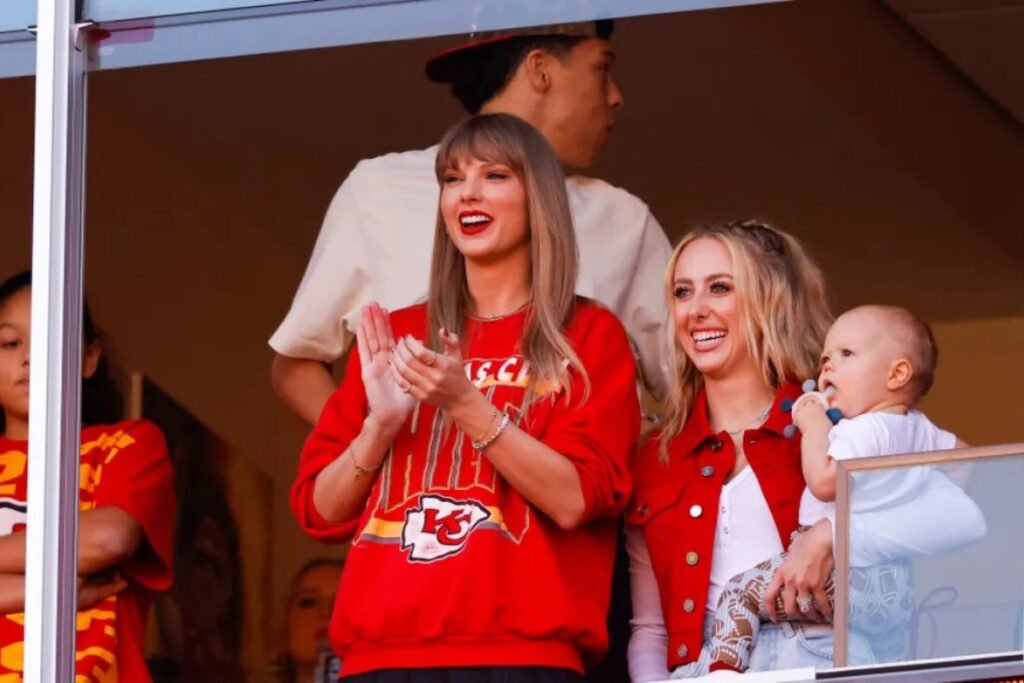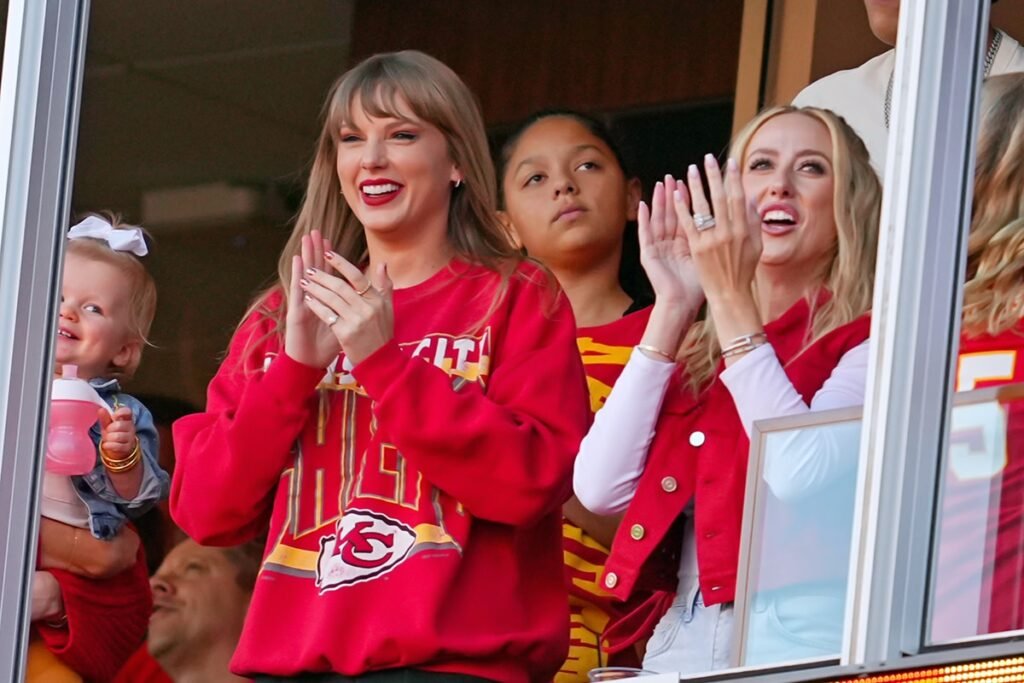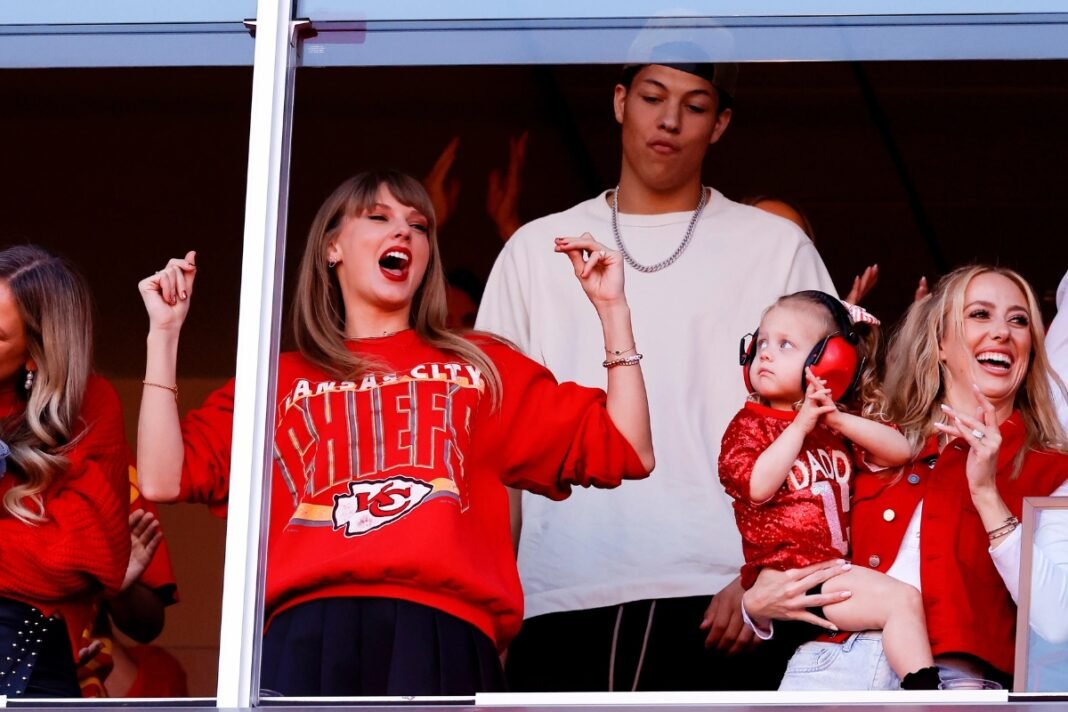Taylor Swift made headlines this weekend as she left Selena Gomez’s wedding in Santa Barbara for a quick trip to Kansas City. Picture this: It’s 11 PM on a Saturday night in Santa Barbara. While the rest of Selena Gomez’s wedding guests are nursing champagne hangovers, Taylor Swift is already wheels-up in a Gulfstream G650, racing against time zones to make a 1 PM kickoff in Kansas City. This isn’t romance—it’s a military operation. In an era when a single paparazzi photo can crash Instagram and every appearance becomes instant folklore, the world’s biggest pop star has turned showing up into an art form worth studying. Behind Swift’s seemingly effortless coast-to-coast weekend lies an invisible army: the pilots on standby, the decoy cars, the style teams working in airplane bathrooms, and the security details who’ve memorized every stadium’s back entrance from Nashville to New York. This is modern love at 41,000 feet—where “having it all” means having a jet broker on speed dial.
When Taylor Swift touched down in Kansas City on Sunday to watch Travis Kelce play against the Baltimore Ravens—less than 24 hours after celebrating Selena Gomez’s marriage to Benny Blanco—she wasn’t just demonstrating devotion. She was showcasing the most sophisticated personal logistics operation in modern celebrity history. The kind of infrastructure that allows someone to be everywhere, always, without ever appearing to break a sweat.
Taylor Swift and The Price of Presence
Let’s talk about what it actually takes to pull off what Swift accomplished last weekend. The Gulfstream G650—the aircraft of choice for the ultra-elite—costs approximately $75 million to purchase outright, or between $10,000 to $15,000 per flight hour to charter. A cross-country flight from Santa Barbara to Kansas City? That’s roughly 1,600 miles, translating to about three and a half hours in the air, plus positioning time, ground operations, and the inevitable weather delays. We’re looking at a minimum $50,000 for the flight alone.
But the aircraft is merely the beginning. Consider the ground game: Swift requires a minimum security detail of six to eight professionals for any public appearance, each earning between $150 to $300 per hour. Factor in pre-advance teams who scout locations days before her arrival, coordinate with local law enforcement, map escape routes, and establish secure perimeters. Then there’s the glam squad—hairstylists, makeup artists, and wardrobe consultants who ensure she steps off that plane looking like she’s just emerged from a spa, not a transcontinental flight. These professionals command day rates ranging from $5,000 to $15,000 each.
The real sophistication, however, lies in the coordination. Swift’s team operates with the precision of a presidential advance operation. They maintain relationships with private terminal operators at dozens of airports nationwide, ensuring discreet arrivals and departures. They work with multiple transportation companies to arrange decoy vehicles and primary motorcades. They coordinate with venue security weeks in advance, often walking through facilities multiple times to identify sight lines, potential bottlenecks, and emergency protocols.

The Architecture of Availability
What Swift has mastered—and what separates her from virtually every other celebrity of her generation—is the art of strategic omnipresence. Over the past month, she has attended nearly every one of Kelce’s games despite simultaneously preparing for the October 3rd release of her 12th studio album, “The Life of a Showgirl,” complete with an accompanying film. This isn’t just commitment; it’s a carefully calibrated demonstration of priorities that reinforces her brand narrative while satisfying the public’s insatiable appetite for her personal story.
Consider the optics: Swift could easily watch Kelce’s games from the comfort of her home, maintaining her relationship privately. Instead, she transforms each appearance into a cultural moment. She’s photographed in designer outfits that immediately trend on social media. She’s captured in VIP boxes alongside Kelce’s family, reinforcing the “serious relationship” narrative. She celebrates his victories with the enthusiasm of someone who genuinely cares, creating authentic moments that resonate far beyond football fandom.
But these moments don’t happen by accident. Behind each appearance is a team that has negotiated with the NFL about camera placement, coordinated with stadium security about entrance protocols, briefed her on the game’s context so she can react appropriately, and arranged for immediate post-game exit strategies. When Swift jumps and cheers at a touchdown, she’s not just a girlfriend watching her partner succeed—she’s performing in one of the most watched productions in American entertainment.
The Friendship Protocol
Swift’s appearance at Gomez’s wedding reveals another layer of this logistical marvel: the prioritization matrix that governs the lives of the mega-famous. In celebrity culture, where every absence is interpreted as shade and every presence analyzed for hidden meaning, Swift’s decision to attend both the Friday rehearsal dinner and Saturday wedding—complete with a heartfelt speech at the reception—before flying out for Kelce’s game sends multiple messages simultaneously.
First, it reinforces her carefully cultivated image as someone who values authentic relationships above all else. Swift and Gomez have been friends for over a decade, navigating the treacherous waters of fame together, weathering public breakups, media scrutiny, and the constant pressure to turn friendship into competition. Swift’s presence at one of the most intimate moments of Gomez’s life—and her willingness to disrupt her own schedule to be there—speaks volumes.
Second, it demonstrates her ability to compartmentalize and execute at the highest level across multiple domains. The same weekend she’s celebrating her best friend’s marriage, she’s supporting her fiancé’s career while presumably overseeing final preparations for an album release that will generate hundreds of millions in revenue. This isn’t work-life balance; it’s work-life integration at a scale most people cannot fathom.
The logistics of managing these overlapping commitments require military-grade scheduling software, redundancy planning, and a team empowered to make split-second decisions when flights are delayed or plans change. Swift’s calendar likely exists in multiple formats—digital, printed, and memorized by key team members—with color-coded priority levels, buffer times built into every commitment, and contingency plans for every conceivable scenario.

The Engagement Effect
Swift’s recent engagement to Kelce—which apparently occurred shortly after she announced her new album on his podcast—adds yet another dimension to this logistical puzzle. Now, every appearance together becomes a page in their public love story, every moment captured and catalogued by millions. The pressure to be present intensifies when your relationship exists as both private reality and public narrative.
Consider the strategic brilliance of announcing the album on Kelce’s podcast. It wasn’t just a cute gesture or a convenient platform—it was a masterclass in cross-promotion and brand synergy. Swift brought her massive audience to her fiancé’s media project while giving her fans unprecedented access to her personal life. The announcement wasn’t made through traditional music industry channels or her own social media; it was embedded in their relationship story, making the album feel like an invitation into their world rather than a commercial transaction.
This kind of strategic thinking extends to every aspect of Swift’s operation. When she attends Kelce’s games, she’s not just being a supportive partner—she’s maintaining her visibility during what would otherwise be an off-season for her public appearances. When she speaks at Gomez’s wedding, she’s reinforcing her position as the linchpin of Hollywood’s most influential female friendship network. When she times her album release to coincide with peak NFL season—when Kelce’s visibility is at its highest—she’s leveraging their combined cultural power to create an unprecedented level of media saturation.
The Cost of Seamlessness
What the public sees—Swift effortlessly gliding from red carpets to stadium boxes to wedding celebrations—obscures the enormous expense and effort required to maintain this level of presence. Industry insiders estimate that top-tier celebrities can spend between $2 million to $5 million annually on security alone. Add in private aviation costs (easily $10 million+ per year for someone traveling as frequently as Swift), personal staff salaries (another $3-5 million), wardrobe and styling expenses (upwards of $2 million), and the infrastructure costs of maintaining multiple residences with 24/7 staff, and you’re looking at a personal operating budget that rivals a mid-sized corporation.
But here’s what makes Swift’s operation particularly sophisticated: the return on investment. Every appearance generates content that feeds her brand, maintains her cultural relevance, and ultimately drives revenue across multiple streams—music sales, streaming, touring, merchandise, and increasingly, the value of her personal brand as it relates to fashion, lifestyle, and relationship models.
When Swift spent $50,000 to fly from Santa Barbara to Kansas City, she wasn’t just buying a plane ticket—she was investing in content that would be shared millions of times across social media, featured in countless news articles, and analyzed by cultural commentators for weeks. The photos of her at the game, the video of her celebrating Kelce’s plays, the narrative of a woman who can be at her best friend’s wedding and her fiancé’s game within 24 hours—this is brand-building at the highest level, and the returns dwarf the costs.

The Future of Fame
What Swift represents is the evolution of celebrity from a state of being into a form of performance art that requires constant, precise execution. She has transformed the traditional celebrity apparatus—which once focused primarily on managing press relations and avoiding scandals—into a proactive content creation machine that turns every moment into a strategic brand touchpoint.
This approach requires an entirely new category of professional: part chief of staff, part creative director, part logistics coordinator. These individuals must possess the organizational skills of corporate executives, the creative instincts of entertainment producers, and the discretion of national security advisors. They’re paid accordingly, with top celebrity handlers commanding salaries well into seven figures.
The infrastructure Swift has built isn’t just about facilitating her current lifestyle—it’s about future-proofing her relevance. In an era when cultural attention spans measure in hours, not years, the ability to be consistently present across multiple platforms and contexts is the most valuable currency in entertainment. Swift doesn’t just use social media or make strategic appearances; she has created a feedback loop where her personal life generates professional opportunities, which in turn provide platforms for sharing her personal life, which drives her professional success, and so on.
As “The Life of a Showgirl” prepares for release on October 3rd, we can expect this machine to shift into an even higher gear. The album title itself—a meta-commentary on the performance of fame—suggests Swift is acutely aware of the apparatus she’s built and the role she plays within it. The accompanying film will likely offer carefully curated glimpses behind the curtain, satisfying the public’s hunger for authenticity while maintaining the essential mystique that makes her fascinating.
The question isn’t whether other celebrities will try to replicate Swift’s model—many already are. The question is whether anyone else has the resources, discipline, and sheer organizational capacity to pull it off. Because what looks like effortless grace from the outside is actually the result of millions of dollars, hundreds of professionals, and thousands of hours of planning.
That Saturday night flight from Santa Barbara to Kansas City wasn’t just about getting from point A to point B. It was a statement: that modern love, modern friendship, and modern fame all require the same thing—an infrastructure capable of moving heaven and earth to make sure you show up when it matters. And in Taylor Swift’s world, everywhere is where it matters, and always is when it matters.
The logistics of love, it turns out, look a lot like the logistics of everything else at the top of the entertainment industry: impossibly complex, extraordinarily expensive, and executed with the kind of precision that makes it all look easy. That’s not just the magic of modern celebrity—it’s the business model.



